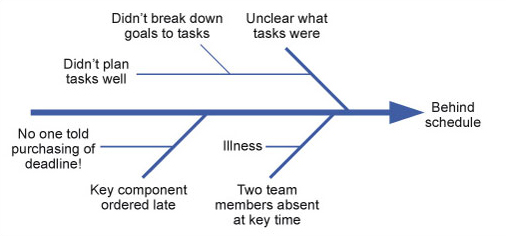5.1 Preparing to make a decision
In an environment where the outcome of a decision must be made by a group of people, or even where it must be made by one person but affects others, it is important to prepare before reaching a decision. The following list sets out steps that should reasonably be taken before making a considered decision.
- Set a deadline by which time the decision must have been made. Communicate the deadline to everyone involved and then enforce this deadline.
- Ensure that the problem is defined and that the required decision is clearly expressed. Avoid making a decision about a symptom (for example, ‘we are late’) when a decision about a problem is needed (‘we need to improve our planning’). Figure 5 shows a simple cause-and-effect diagram to find the reasons for a symptom. Whilst this shows quite specific reasons, it points to a general lack of proper planning. In this example, the symptom ‘Unclear what tasks were’ was in turn caused by ‘Didn’t plan tasks well’, which in turn was caused by ‘Didn’t break down goals to tasks’. A line is drawn from each cause to a more specific cause.
- Determine options for solving the problem. For each option determine its benefits and any problems it may cause; for example, an ‘ideal’ solution may take too long if you are under pressure and would be discarded as a result. Options can be ranked according to their feasibility and their desirability.

